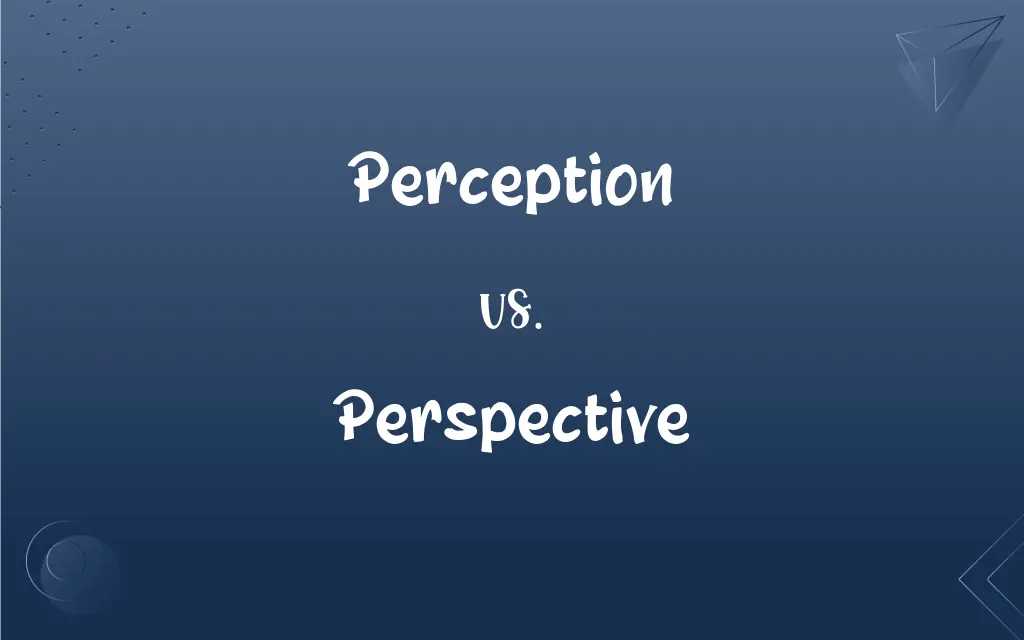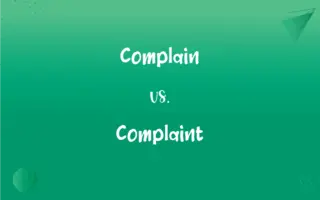Perception vs. Perspective: What's the Difference?
Edited by Aimie Carlson || By Harlon Moss || Updated on October 24, 2023
"Perception" relates to how one senses or understands something, while "perspective" refers to a viewpoint or particular way of considering something.

Key Differences
"Perception" primarily revolves around the process of becoming aware of something through the senses. It's our immediate sensory response to stimuli, whether visual, auditory, or otherwise. On the contrary, "perspective" is more about one's viewpoint or angle of seeing things, often shaped by experience, culture, or knowledge.
At its core, "perception" is about interpretation. It involves processing the information our senses collect, leading us to a particular understanding or feeling. "Perspective," on the other hand, is a broader term that denotes a specific stance or outlook on a subject, often influenced by personal beliefs, background, or context.
"Perception" can be quite personal and might differ significantly between individuals based on their sensory experiences. For instance, two people might perceive a song differently, one finding it melancholic and the other uplifting. In contrast, "perspective" tends to discuss broader viewpoints. Two individuals might have different perspectives on an event based on their cultural or personal backgrounds.
While "perception" often feels immediate and reactive, deriving directly from our sensory experiences, "perspective" is more contemplative. It represents an individual's particular way of framing or considering an issue or event. For example, one's perception of a painting might be that it's colorful and vibrant, while their perspective might be influenced by their knowledge of the artist's history or the painting's era.
It's essential to recognize that while "perception" and "perspective" can sometimes influence each other, they serve different roles in our cognition and understanding. Our perceptions might shape our perspectives over time, and conversely, our perspectives can influence how we perceive certain stimuli.
ADVERTISEMENT
Comparison Chart
Nature
Sensory and interpretative.
Viewpoint or stance.
Influences
Immediate sensory input.
Experience, culture, knowledge.
Usage
Relates to personal interpretation of stimuli.
Refers to a way of looking at or considering something.
Flexibility
Can vary moment-to-moment.
Tends to be more stable, based on accumulated knowledge.
Context
Often individual and immediate.
Broader, considering wider contexts and backgrounds.
ADVERTISEMENT
Perception and Perspective Definitions
Perception
The act of sensing or becoming aware through the senses.
Her perception of the aroma was that of fresh roses.
Perspective
The relation or proportion of aspects of a subject to each other.
The novel offers multiple characters' perspectives on the events.
Perception
An intuitive recognition or understanding.
She has a keen perception of human motives.
Perspective
A particular way of considering or viewing something.
From an economist's perspective, the policy makes sense.
Perception
Personal interpretation of sensory information.
His perception of the song's mood was different from mine.
Perspective
A viewpoint or stance influenced by individual experiences.
Growing up abroad gave her a unique perspective on culture.
Perception
The process of recognizing and interpreting sensory stimuli.
The optical illusion challenges our visual perception.
Perspective
The art of drawing objects on a surface to give the illusion of depth.
The painting showcases Renaissance perspective techniques.
Perception
Insight or intuition gained by perceiving.
Through meditation, he gained a clearer perception of his purpose.
Perspective
A mental view or outlook.
The experience changed his perspective on friendship.
Perception
The process of perceiving something with the senses
The perception of a faint sound.
Perspective
A view or vista.
FAQs
Are perceptions consistent among people?
Perceptions can vary widely among individuals based on sensory differences, past experiences, and other factors.
Can art influence one's perspective?
Absolutely, art can offer new viewpoints or challenge existing ones, influencing perspective.
Can health conditions affect perception?
Yes, conditions like migraines or neurological issues can influence sensory perception.
Can two people have the exact same perception of an event?
While similarities might exist, exact perceptions are often unique due to individual sensory experiences and interpretations.
Does language influence perception?
Yes, language can shape how we categorize and perceive the world around us.
How do perceptions relate to biases?
Biases can shape and influence our perceptions, making us more prone to see things in a particular way.
Is a "global perspective" about understanding worldwide viewpoints?
Yes, it refers to understanding and considering various cultural, societal, and international viewpoints.
How do life experiences influence perspective?
Life experiences, both positive and negative, can deeply influence and shape one's perspective on various matters.
Can animals have perceptions?
Yes, animals perceive the world around them, though their perceptions can be different from humans due to sensory differences.
Can reading influence perspective?
Definitely, reading broadens horizons and offers insights into different viewpoints, enriching perspective.
Does perspective influence decision-making?
Yes, one's viewpoint or perspective can heavily influence choices and decisions they make.
Is perspective purely mental?
While largely mental, perspective is also influenced by cultural, societal, and experiential factors.
Can perspectives be wrong?
Perspectives are subjective viewpoints; while they can be uninformed or biased, labeling them as "right" or "wrong" is often subjective itself.
Is perspective linked to empathy?
Yes, empathy often involves understanding and considering another's perspective.
Is perception linked to reality?
Perception is our personal interpretation of reality, but it might not always align with objective reality.
Is perception always based on reality?
No, perception is subjective and can be influenced by various factors, sometimes leading to misinterpretations.
Can one's perspective change over time?
Yes, perspectives can evolve based on new experiences, knowledge, or changes in belief.
Are there scientific tests for perception?
Yes, there are various tests, like visual or auditory tests, to study and measure perception.
Can training or education change perception?
Training, especially in areas like music or art, can refine and alter perception.
How does age influence perspective?
Age, with associated experiences and knowledge, can significantly shape and modify one's perspective.
About Author
Written by
Harlon MossHarlon is a seasoned quality moderator and accomplished content writer for Difference Wiki. An alumnus of the prestigious University of California, he earned his degree in Computer Science. Leveraging his academic background, Harlon brings a meticulous and informed perspective to his work, ensuring content accuracy and excellence.
Edited by
Aimie CarlsonAimie Carlson, holding a master's degree in English literature, is a fervent English language enthusiast. She lends her writing talents to Difference Wiki, a prominent website that specializes in comparisons, offering readers insightful analyses that both captivate and inform.































































